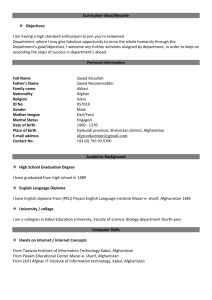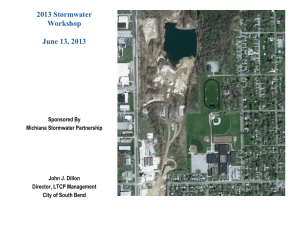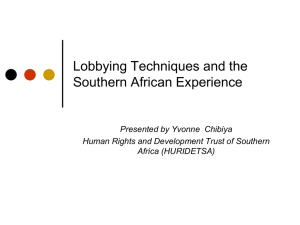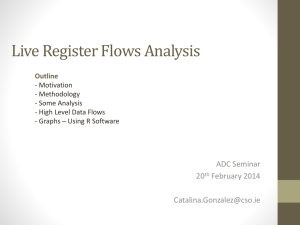JT11 - International Journal of Engineering and Technology
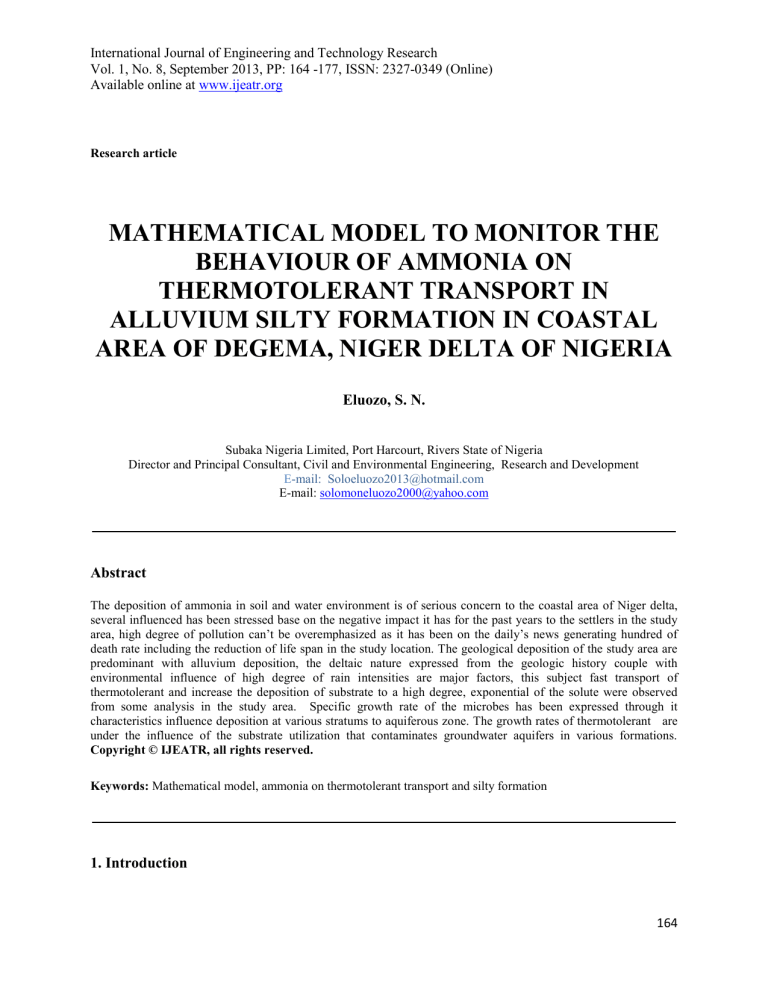
International Journal of Engineering and Technology Research
Vol. 1, No. 8, September 2013, PP: 164 -177, ISSN: 2327-0349 (Online)
Available online at www.ijeatr.org
Research article
MATHEMATICAL MODEL TO MONITOR THE
BEHAVIOUR OF AMMONIA ON
THERMOTOLERANT TRANSPORT IN
ALLUVIUM SILTY FORMATION IN COASTAL
AREA OF DEGEMA, NIGER DELTA OF NIGERIA
Eluozo, S. N.
Subaka Nigeria Limited, Port Harcourt, Rivers State of Nigeria
Director and Principal Consultant, Civil and Environmental Engineering, Research and Development
E -mail: Soloeluozo2013@hotmail.com
E-mail: solomoneluozo2000@yahoo.com
_____________________________________________________________________________________________
Abstract
The deposition of ammonia in soil and water environment is of serious concern to the coastal area of Niger delta, several influenced has been stressed base on the negative impact it has for the past years to the settlers in the study area, high degree of pollution can’t be overemphasized as it has been on the daily’s news generating hundred of death rate including the reduction of life span in the study location. The geological deposition of the study area are predominant with alluvium deposition, the deltaic nature expressed from the geologic history couple with environmental influence of high degree of rain intensities are major factors, this subject fast transport of thermotolerant and increase the deposition of substrate to a high degree, exponential of the solute were observed from some analysis in the study area. Specific growth rate of the microbes has been expressed through it characteristics influence deposition at various stratums to aquiferous zone. The growth rates of thermotolerant are under the influence of the substrate utilization that contaminates groundwater aquifers in various formations.
Copyright © IJEATR, all rights reserved.
Keywords: Mathematical model, ammonia on thermotolerant transport and silty formation
_____________________________________________________________________________________________
1. Introduction
164
International Journal of Engineering and Technology Research
Vol. 1, No. 8, September 2013, PP: 164 -177, ISSN: 2327-0349 (Online)
Available online at www.ijeatr.org
Ammonia is used in fertilizer and animal feed production and in the manufacture of fibbers, plastics, explosives, paper, and rubber. It is used as a coolant, in metal processing, and as a starting product for many nitrogen-containing compounds ( 3 ). Ammonia and ammonium salts are used in cleansing agents and as food additives ( 1,4 ), and ammonium chloride is used as a diuretic [Source: Hazardous Substances Data Bank: Ammonium chloride.
Bethesda, MD, National Library of Medicine, 1990, WHO 1996) Microelements are nutritional components that occur and function in many locations and on many levels of organism. They are present in the organism at very low concentrations and are an indispensable component in numerous enzymatic, catalytic, regulating and activating processes, usually as activators and co-factors. Microelements enter the organism through the feed; in developing foetuses they enter through the placenta. Concentration of microelements in blood of supplemented mothers correlates positively with concentrations in calf blood. An important source of microelements for a newborn calf is the colostrums (Abdurrahman and Kincaid 1993; Lacetera 1996; Underwood and Suttle 1999; Pavlata et al. 2003).
Microelements also affect the quality and composition of the colostrums and milk and affect the health of the udder.
For example, the colostrums and milk of selenium-supplemented cows has a higher concentration of selenium and contains a higher concentration of immunoglobulin’s; cows supplied with selenium have lower incidence of mastitis
(Hogan et al. 1993; Knowles et al. 1999; Pavlata et al. 2004a); supplementation of zinc to dairy cows decreases the number of somatic cells in milk (Pechová et al. 2006), and copper affects the ability of neutrophils to kill phagocytosed bacteria and decreases susceptibility of the udder to infection (Scaletti et al. 2003). Microelement deficiencies in dairy and beef cattle in the Czech Republic are frequent (Pavlata et al. 2005a; Slavík et al. 2006;
Podhorský et al. 2007). Ruminant nutrition routinely uses several methods and forms to supplement microelements.
A slightly problematic period for ensuring adequate supplementation of microelements to dairy cows is the dry period, when only a small amount of seeds is usually fed and microelements are thus difficult to add to the feed.
Application forms include supplementation by adding minerals to the feed, mineral licks, and/or single/repeated injection of individual microelements, or combinations of the above. Other methods of supplementation include boluses, projectiles or pills (depending on the shape of administration form), containing a precisely defined amount of microelements combined with a carrier or auxiliary substance. Another method of supplementation of microelements consists in long-acting injections (Lee et al. 1999; Pavlata 2004a; Kinal et al. 2004; Pechová et al.
2006; Mulligan et al. 2006; Chládek and Zapletal 2007, Eluozo 2013).
2
.
Theoretical background
The deposition of ammonia influencing the transport of thermotolerant has been thoroughly evaluated, the conceptualization of the study was to ensure the behaviour of ammonia are thoroughly expressed in the system, the influence of ammonia on the deposition of thermotolerant in the formation are base on different conditions in the environment, the climatic condition play major roles in the behaviour and influence of the ammonia in soil and water environment, such condition express in were considered in the developed governing equation this will express the deposition and behaviour of ammonia in the study locations, the developed governing equation were
165
International Journal of Engineering and Technology Research
Vol. 1, No. 8, September 2013, PP: 164 -177, ISSN: 2327-0349 (Online)
Available online at www.ijeatr.org
derived to generate a model that will expressed the behaviour of ammonia including the deposition of thermotolerant in soil and water environment in the study area. Several boundary values were considered in the system to ensure that the behaviour of thermotolerant are thoroughly expressed under the influence of variation of soil stratification through geologic history of the study area, the model if applied will express the exponential condition of thermotolerant in the study area, since the study area is situated in coastal area of Niger delta region, the influence from climatic condition developed lots variation in microbial behaviour in the strata. The model expressed several derived solution model considering several condition under the influences of variation of substrate utilizations deposition in the formations, the developed model will definitely express the behaviour and deposition of ammonia in the coastal area of Degema.
3. Governing Equation
V
Cs
t
Cs
z q z
C s
Ds
Cs
z
M b
o
o
V
Cs
1
t x
Cs
( o )
0
0
M b
o
o
Cs
1
z
Cs
1
t
V
Cs
2
t t
0 , B
D s
Cs
2
z K
Ao
C
A
C
A
Cs
z
Cs
t K
So
Cs
Cs
Cs
z K
Ao
C
A
C
A
…….. (1)
……………… (2)
……………… (3)
……………… (4) x
0 t
Cs
( o )
0
0
Cs
2
t t
0 , B
……………… (5)
V
Cs
3
t
t
Cs
( o )
0
0
Cs
3
t K
Cs o so
C o
……………… (6)
……………… (7)
166
International Journal of Engineering and Technology Research
Vol. 1, No. 8, September 2013, PP: 164 -177, ISSN: 2327-0349 (Online)
Available online at www.ijeatr.org
Cs
3
t t
0 , B
V t x
0
0
Cs
Cs
4
t
( o )
0
D s
Cs
4
z
Cs
4
t
V
Cs
5
t t
0 , B
Cs
5
z q z
Cs t x
0
0
Cs
( o )
0
Cs
5
t
M b
o
o t
Cs
6
z
0 , B
Cs
6
t K
Ao
C
A
C
A x
Cs
( o )
0
0
Cs
t t
0 , B
Applying direct integration on (2)
Cs
1
t
M b
o
o
K
1
0
Again, integrate equation (14) directly yield
VCs
M b
o
o
K
1
K
2
Subject to equation (3) we have
Cs
( o )
K
2
Subjecting equation (15) to (3)
……………… (8)
……………… (9)
……………. (10)
…………… (11)
…………… (12)
…………… (13)
……....…… (14)
…………… (15)
…………… (16)
167
International Journal of Engineering and Technology Research
Vol. 1, No. 8, September 2013, PP: 164 -177, ISSN: 2327-0349 (Online)
Available online at www.ijeatr.org
At
Cs
1
t
0 t
Cs
( o )
0
Cs o
Yield
O
VCs o
K
2
K
2
VC o
……………… (17)
So that we put (16) and (17) into (15), we have
Cs
1
VCs
1 t
M b
o
o
Cst
Cs o
Cs
1
V
Cs o
M b
o
o
Cst
………………
………………
(18)
(19)
Cs
1
Cs
1
Vt
Cs o
Cs
1
M b
o
o
……………… (20)
Cst
Cs o
V
Cs
2
t
Cs
2
z K
Ao
C
A
C
A
……… (4)
……………… (21)
We approach this system using the Bernoulli’s method of separation of variables.
I.e. Cs
2
ZT ……………… (22)
Cs
2
t
Cs
2
z
ZT
Z 1 T
1 ………………
………………
(23)
(24)
Put (23) and (24) into (25), so that we have
VZT
1
K
Ao
C
A
C
A
Z
1
T
VZT
1
VT 1
T
K
Ao
C
A
C
A
Z 1
Z
2
Hence
VT
1
T
2
K
Ao
C
A
C
A
Z
1
2
Z
0
………………
(25)
……………… (26)
………………
………………
(27)
(28)
168
International Journal of Engineering and Technology Research
Vol. 1, No. 8, September 2013, PP: 164 -177, ISSN: 2327-0349 (Online)
Available online at www.ijeatr.org
From (27)
T
ACos
V t
B Sin
V z ……………… (29)
And (28) gives
T
2
Cs V t
……………… (30)
By substituting (28) and (29) into (22) we get
Cs
2
A Cos
V t
Cs o
B Sin
V z
Cs
2
V t
Ac
………………… (31)
………………… (36)
Equation (31) becomes
Cs
2
Cs o
2
K
Ao
C
A
C
A t
Cos
V z
Again at
Cs
2
t
t
0 ,
z
0 ,
B
0
………………… (33)
Equation (33) becomes
Cs
2
t
Cs o
V
2
K
Ao
C
A
C
A t
Sin
V z
I.e. 0
Cs o
V
Sin
V
0
Cs o
V
0 Considering NKP
0
Cs o
V
Sin
V
B
n
2
V
So that equation (33) becomes
Cs
2
Cs o
n
2 2
V
2
K
Ao
C
A
C
A Cos n
2 V
V z
………………… (34)
………………… (35)
………………… (36)
………………… (37)
………………… (38)
169
International Journal of Engineering and Technology Research
Vol. 1, No. 8, September 2013, PP: 164 -177, ISSN: 2327-0349 (Online)
Available online at www.ijeatr.org
n
2 2
V
Cs
2
Cs o
2
K
Ao
C
A
C
A Cos n
2
z ………………… (39)
We consider equation (6)
V
Cs
3
t
Cs
3
z Ks o
Cs
Cs
…………
(6)
We approach the system by applying Bernoulli’s method of separation of variables.
Cs
3
ZT ………………… (40)
Cs
3
t
ZT
1
Cs
3
z
Z
1
T
………………… (41)
………………… (42)
Again, we put (41) and (42) into (40), so that we have
VZT
1
Ks o
Cs
Cs
3
Z
1
T ………………… (43)
I.e.
VT
T
1
Ks o
Cs
Cs
3
Z
1
Z
2
Hence
VT
1
T
2
I.e.
Ks o
Cs
Cs
Z
1
2 z
0
From (46)
T
t
ACos
V
Z
BSin
z
V
And (46) gives
T
Cs o
2
V t
By substituting (47) and (48) into (40), we get
………………… (44)
………………… (45)
………………… (46)
………………… (47)
………………… (48)
170
International Journal of Engineering and Technology Research
Vol. 1, No. 8, September 2013, PP: 164 -177, ISSN: 2327-0349 (Online)
Available online at www.ijeatr.org
Cs
3
A
Cos
V z
B Sin
V z
2
Cs V t
………………… (49)
Subject (54) to condition in (6) so that we have
Cs o
Ac ………………… (50)
Cs
3
Cs o
2
V t Cos
V
Z
Again at
Cs
3
t t
0 , B
Equation (51) becomes
………………… (51)
Cs
2
t
V
Cs o
2
Ks o
Cs
Cs
Sin
V z
I.e. 0
Cs o
V
Sin
V
0
Cs o
V
0 Considering NKP
………………… (52)
………………… (53)
Which is the substrate utilization for microbial growth rate (population) so that
0
Cs o
V
Sin
V
B
V
n
2
………………… (54)
………………… (55)
n
2
V
So that equation (57)
………………… (56)
Cs
3
Cs o
n
2 2
V
2
K
Ao
C
A
C
A Cos n
2 V
V z
Cs
3
Cs o
n
2 2
V t
2 V Cos n
2 z
………………… (57)
………………… (58)
171
International Journal of Engineering and Technology Research
Vol. 1, No. 8, September 2013, PP: 164 -177, ISSN: 2327-0349 (Online)
Available online at www.ijeatr.org
Now we consider equation (8)
V
Cs
4
t
Ds
Cs
4
z
………… (8)
Using Bernoulli’s method of separation of variables, we have
Cs
4
Cs
4
t
ZT
ZT
1
Cs
4
Z
Z
1
T
Put (60) and (61) into (8), so that we have
VZT
1
DsZ
1
T
I.e.
VT
1
T
Ds
Z
1
Z
Ds
Z
1
Z
T
A
V z
And
Z
B V z
Put (65) and (60) into (59), gives
Cs
4
A
Ds z
B
Ds z
Cs
4
AB ( x
t )
Ds
Subject equation (67) to (8) yield
Cs
4
( o )
C o
So that equation (69) becomes
Cs
4
Cs o
( x
t )
Ds
Now, we consider equation (9)
V
Cs
5
t
Cs
z
5 q z
C s
…………
Apply Bernoulli’s method, we have
(9)
……………… (59)
………………
………………
………………
………………
……………… (64)
………………
………………
………………
………………
……………… (69)
………………
(60)
(61)
(62)
(63)
(65)
(66)
(67)
(68)
(70)
172
International Journal of Engineering and Technology Research
Vol. 1, No. 8, September 2013, PP: 164 -177, ISSN: 2327-0349 (Online)
Available online at www.ijeatr.org
Cs
5
ZT ………………
Cs
5
t
Cs
5
Z
ZT
Z
1
T
1
Put (72) and (73) into (9), so that we get
………………
………………
VXT
1
I.e.
VT
T
1
Z
1
Tq z
C s
Z
1 q z
C s
Z
………………
(71)
(72)
(73)
(74)
……………… (75)
VT
1
T
Z
1
T
Z
And
Z
A
T
V
B
q z
C s
Z
………………
………………
………………
(76)
(77)
(78)
……………… (79)
Put (78) and (79) into (71), gives
Cs
5
Cs
5
A
q z
C s t
AB ( x
t )
q z
C s
B q z
C s t
………………
………………
(80)
(81)
Subject equation (83) and (84) into (74) yield
Cs
5
( o )
Cs o
So that equation (81) and (82) becomes
Cs
5
( o )
Cs o
( t
x )
q z
C s
………………
………………
Now, we consider equation (11) which is the steady flow rate of the system
M b
o
o
Cs
6
z
Cs
6
z K
Ao
C
A
C
A
….… (11)
Applying Bernoulli’s method of separation of variables, we have
Cs
6
ZT ………………
(82)
(83)
(84)
173
International Journal of Engineering and Technology Research
Vol. 1, No. 8, September 2013, PP: 164 -177, ISSN: 2327-0349 (Online)
Available online at www.ijeatr.org
Cs
6
t
ZT
1 ………………
Cs
6
Z
Z
1
T ………………
Put (85) and (86) into (11), so that we have
M b
o
o
Z
1
T
I.e. M b
o
o
Z
1
Z
K
Ao
C
A
C
A
Z
1
T
K
Ao
C
A
C
A
Z
1
Z
M b
o o
Z
1
Z
………………
………………
………………
K
Ao
C
A
C
A
Z
Z
1
Z
A
M b
o
o
Z
And Z
B K
Ao
C
A
C
A
Z
………………
………………
(85)
(86)
(87)
(88)
(89)
(90)
(91)
……………… (92)
Put (91) and (92) into (84) gives
Cs
6
A
M
b
o
o B
M b
o
o
Cs
6
AB ( x
x )
M b
o
o x
Subject equation (93) and (94) into (94) yield
Cs
6
( o )
C o
………………
(93)
……………… (94)
……………… (95)
So that equation (96) becomes
Cs
6
Cs o
( x
x )
M b
o o
……………… (96)
Now, assuming that at the steady flow there is no NKP for substrate utilization, our concentration is zero so that equation (96) becomes
174
International Journal of Engineering and Technology Research
Vol. 1, No. 8, September 2013, PP: 164 -177, ISSN: 2327-0349 (Online)
Available online at www.ijeatr.org
Cs
6
0 ………………
(97)
Therefore, solution of the system is of the form
Cs
Cs
1
Cs
2
Cs
3
Cs
4
Cs
5
Cs
6
……………… (98)
We now substitute (20), (39), (58), (70), (83) and (96) into (98), so that the model is of the form
C
Cs o
Cs o
n
2
2
V
2
K
A
C
A
C
A
Cos n
2
Z
Cs o
n
2
2
V
2 V
Cs o
( x
t )
Ds
Cs o
( t
x )
q z
C s
Cs o
( t
x )
M b
o
o
Cos
V
2
Z
………………
(99)
Cs
Cs o
1
n
2
2
V
2
K
A
C
A
C
A
Cos n
2
n
2
2
V
2 V
Cos n
2
( t
z )
q z
C s
( t
x )
M b
o
o
……………… (100)
The final model equations are expressed in equation [100]. The derived solution were formulated to ensure that the expression generate the exact solution for the study area under study the above derived solutions express different method under the influence of Thermotolerant behaviour in the study location several behaviour of thermotolerant were expressed through mathematical method through the formulated system. the expressed model developed will definitely monitor the deposition rate of ammonia and thermotolerant in the study area.
4. Conclusion
The behaviour of thermotolerant in soil and water environment has been expressed, the study was to monitor the rate of migration in different formations under the influence of formation characteristics in the study area, several condition were evaluated due high rate of environmental influences in the deltaic location, the concepts was to ensure that the deposition of ammonia are expressed by evaluating the growth rate of thermotolerant and the degree of migration under the influences of plug flow. The developed governing equation were derived considering theses conditions show the exponential \phase of ammonia with respect to growth rate of bacterial at various formations.
Formation characteristics were found to influence the deposition of ammonia at various formations down to
175
International Journal of Engineering and Technology Research
Vol. 1, No. 8, September 2013, PP: 164 -177, ISSN: 2327-0349 (Online)
Available online at www.ijeatr.org
groundwater aquifers. Experimental results were compared after simulation with theoretical values this implies that the model can be applied to monitor the deposition of ammonia and growth rate of bacterial on homogenous formation.
References
[1] Chládek, G., Zapletal, D., 2007. A free-choice intake of mineral blocks in beef cows during the grazing season and in winter. Livest Sci 106, 41-46
[2] World Health Organization, 1996. Originally published in Guidelines for drinking-water quality, 2nd ed. Vol. 2.
Health criteria andother supporting information.
[3] Abdelrahman, M.M., Kincaid, R.L., 1993. Deposition of copper, manganese, zinc, and selenium in bovine fetal tissue at different stages of gestation. J Dairy Sci 76, 3588-3593
[4] Lacetera, N., Bernabucci, U., Ronchi, B., Nardone, A., 1996. Effects of selenium and vitamin E administration during a late stage of pregnancy on colostrum and milk production in dairy cows, and on passive immunity and growth of their offspring. Am J Vet Res 57. 1776-1780
[5] Pavlata, L., Pechová, A., Dvořák, R., 2004b. Microelements in colostrum and blood of cows and their calves during colostral nutrition. Acta Vet Brno 73, 421-429
[6] Pavlata, L., Pechová, A., Illek, J., 2000. Direct and indirect assessment of selenium status in cattle - a comparison. Acta Vet Brno 69, 281-287
[7] Pavlata, L., Podhorský, A., Pechová, A., Chomát, P., 2005a. Differences in the occurrence of elenium, copper and zinc deficiencies in dairy cows, calves, heifers and bulls. Vet Med-Czech 50, 390-400
[8] Pavlata, L., Prášek, J., Podhorský, A., Pechová, A., Haloun, T., 2003. Selenium metabolism in cattle: maternal transfer of selenium to newborn calves at different selenium concentrations in dams . Acta Vet Brno 72, 639-646
[9] Pavlata, L., Prášek, J., Filípek, J., Pechová, A., 2004a. Influence of parenteral administration of selenium and vitamin E during pregnancy on selected metabolic parameters and colostrum quality in dairy cows at parturition. Vet
Med-Czech 49, 149-155
[10] Pechová, A., Pavlata, L., Hofírek, B., Dvořák, R., 2004. Metabolic profile test. In: Hofírek B, Pechová A,
Doležel R, Pavlata L, Dvořák R, Fleischer P et al. (Eds): Herd health management in dairy cattle (in Czech). VFU
Brno, pp. 31-49
[11] Podhorský, A., Pechová, A., Dvořák, R., Pavlata, L., 2007. Metabolic disorders in dairy calves in postpartum period. Acta Vet Brno 76, 45-53.
[12] Scaletti, R.W., Trammell, D.S., Smith, B.A., Harmon, R.J., 2003. Role of dietary copper in enhancing resistance to Escherichia coli mastitis . J Dairy Sci 86, 1240-1249.
[13] Lee, J., Masters, D.G., White, C.L., Grace, N.D., Judson, G.J., 1999. Current issues in trace element nutrition of grazing livestock in Australia and New Zealand. Aust J Agric Res 50, 1341-1364
[14] Slavík, P., Illek, J., Zelený, T., 2006. Zinc and copper status of beef cattle in the Šumava region, Czech
Republic. Acta Vet Brno 75, 485-488.
[15] Mulligan, F., O’Grady, L., Rice, D., Doherty, M., 2006. A herd health approach to dairy cow nutrition and production diseases of the transition cow. Anim Reprod Sci 96, 331-353.
176
International Journal of Engineering and Technology Research
Vol. 1, No. 8, September 2013, PP: 164 -177, ISSN: 2327-0349 (Online)
Available online at www.ijeatr.org
[16] Kinal, S., Rzasa, A., Korniewicz, A., 2004. Mineral bioplex supplementation of diets for cows affects colostrums quality and immunoglobulins in calf blood serum. J Anim Feed Sci 13 (Suppl.), 79-82.
[17] Krys, Š., Lokajová, E., Podhorský, A., Pavlata L., 2009. Microelement Supplementation in Dairy Cows by
Mineral Lick acta vet. brno 78, 29–36; doi:10.2754/avb200978010029.
[18] Eluozo S.N. 2013 Modeling and simulation to predict partial deposition of ammonia and specific growth rate of bacterial in homogeneous formation in Obio/Akpor, rivers state of Nigeria Scientific Journal of Review (2013) 2(2)
62-72, pp1
177
